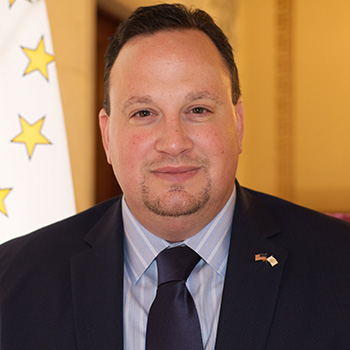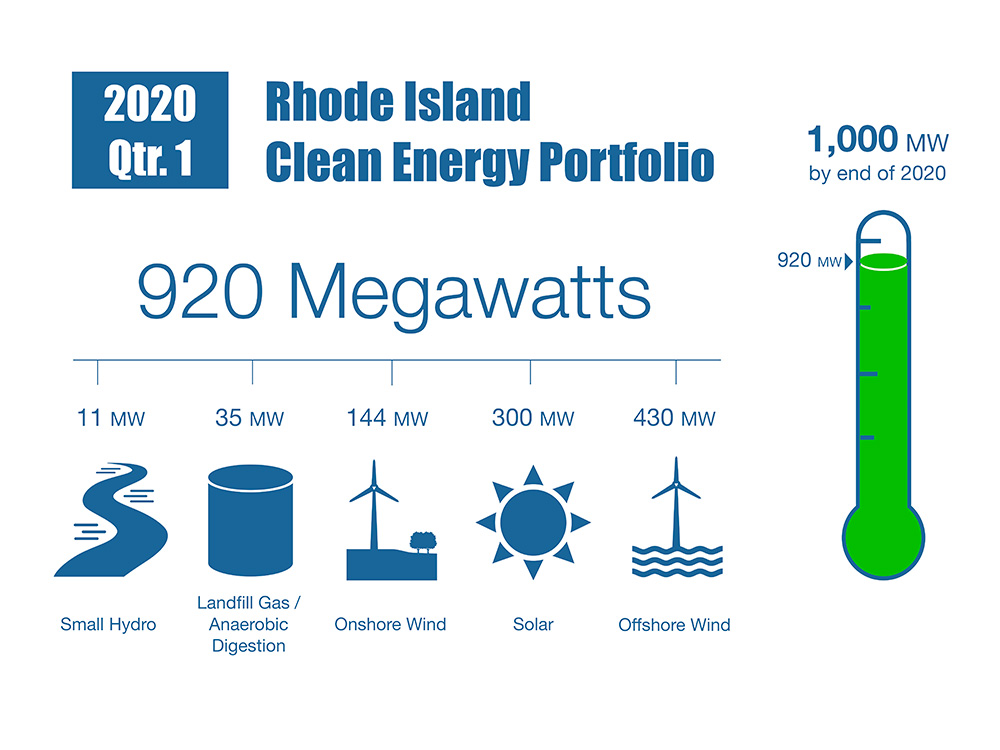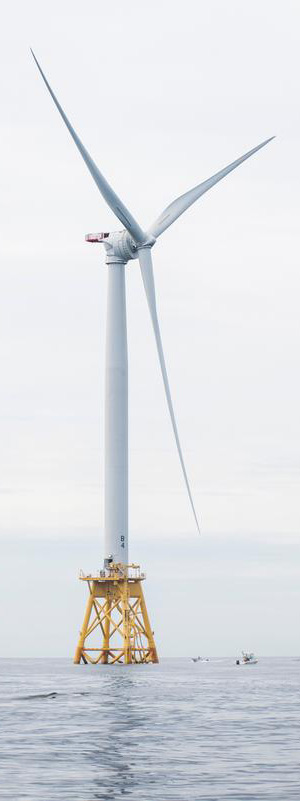An Interview with Nicholas Ucci
Acting Commissioner of the Rhode Island Office of Energy Resources

Under Governor Gina Riamondo’s leadership, Rhode Island is at the forefront of the clean energy revolution. Just a couple of years ago, the governor set an ambitious goal to increase our clean energy portfolio ten-fold by the end of 2020 – that’s 1,000MW. Offshore wind will be a major part of this effort, with the Block Offshore Wind Farm and the recently announced contract for the 400MW Revolution Offshore Wind Farm. Thanks to these and along with continued growth in other renewables, we’re already approaching 900MW. We certainly expect to meet the governor’s goal by the end of the year.
Governor Riamondo is bold. Back in January she issued Executive Order 20-1, which will put Rhode Island on a faster path than any other state in the country, to go 100% renewables by 2030. We at the Office of Energy Resources have been charged to do this work and develop a strategy and pathways forward. This will include hiring consultants to support the analytics, which will look at both the costs and benefits, not just from the energy perspective but also from an economic development perspective. By the end of the year we will report back to the governor with a detailed list of policies, programs and the legislative changes that will be required to make her very ambitious goal. The governor has taken her leadership responsibility to mitigate greenhouse gas emission across the economy, while also making our communities more resilient to the very real impacts of climate change that are already taking place. These issues are critically important to a state with more than 400 miles of coastline.


To step outside offshore wind for a moment, I’d like to say that the governor also is exerting bold leadership in regards to transportation, which represents about 36% of greenhouse gas (GHG) emissions, through our participation and continued engagement with the Transportation and Climate Initiative, working with other states throughout the Northeast to develop similar pathways for the decarbonization of the transportation sector and she also launched a heating sector transformation initiative that we are helping to lead with a report due soon, which will outline decarbonization pathways for the heating sector. This again represents about 35% of GHG emissions with a 10-year action plan that will put us on the path towards meeting that reality.
We are moving forward on all fronts. This is not an energy-only paradigm that we’re looking to develop. We have full engagement across the administration, including the Department of Environmental Management, Commerce Corporation, the Department of Labor and Training and other partner agencies to really push hard on not just moving the needle from an energy market perspective but insuring that we have the workforce and supply chain and businesses needed to grow these industries and support these emerging technologies that are so critical to an economy-wide decarbonization.
This is an important point. A 100% renewable grid is critical if we are to, in any meaningful way, decarbonize the heating and transportation sectors. So first and foremost, and the governor clearly has put emphasis on that, because it is foundational to the broader economy-wide transformations that need to take place. We’re third in the nation in energy leadership innovation. We need people, we need workers to continue to insulate homes, to install cold climate air-source heat pumps, to put in electric vehicle charging stations, as well as the networks needed to sustain those changes. We need folks who can build, manufacture and site these complex clean energy projects like Revolution Wind and the Block Island wind farm and other offshore wind farms that will be taking place up and down the coast. We need to take a 360 degree perspective on what will be needed to be successful to get to a decarbonized future and with the governor’s leadership to do all that we can to make that happen.
There are two ways of looking at offshore wind. There’s the state-centric perspective and then there’s the broader industry across North America. From the Rhode Island perspective, pointing back at the governor’s executive order to meet 100% of our electricity deliveries through renewable energy by 2030. We will be engaging in this analysis in over the coming year. I fully expect that Rhode Island will continue to use the all of the above approach and recognize the need to continue local renewable development, but in light of some of the constrains we have as a small, urbanized state with a limited amount of land, we’re not going to be able to meet all of that demand from small solar, for example. We do have these opportunities off our coast to drive renewables at scale. Both small-scale renewables and larger scale like offshore wind farms have produce different types of benefits or positive externalities to the workforce, to the supply chain, for economic development and infrastructure investments. It’s important that we move those forward together and our analysis will take a look at different types of resource portfolios within the concept of a regional grid – remember, everything that RI does is integrated with what New England does as a whole – we’ll take that perspective and do the analysis and we’ll look at what are the opportunities and costs to go big. I fully expect that offshore wind will be a significant part of our future from the energy perspective. We don’t have any concrete plans at this point in time to, for example, issue another procurement, but we’re certainly considering all of our options and look forward to being informed by our analysis.
The industry-wide perspective – we know that these offshore wind farms are in the queue with thousands of megawatts planning to be built over time between the targets set forth by New York, Massachusetts, Connecticut, etc. These will require significant quantities of workers, supply chain activities and ports and we think that Rhode Island is extremely well positioned to get more than our fair share. Every state will benefit that’s engaged in this. There’s no doubt of that. Connecticut is looking at some significant investment in the New London area, New York has a lot of economic development activity as well. But frankly, for the industry to grow at the levels we expect it to and maybe need to in order to reduce greenhouse gas emissions to the level that we need to, all of these states will get significant opportunities to grow jobs and attract investment dollars. We want to be strategic about how we do that. We want to be able to find opportunities to partner across borders, understanding that if New England as a whole can collaborate in a way that is attractive to the industry, then we can set ourselves apart from other areas of the country that are also competing for the same dollars.
We really are, under the governor’s leadership, not just looking at what we can do within our own borders, but looking at how we can work with our neighbors to put forward the best that New England has to offer, because all of our ports will be needed, not just Rhode Island’s ports at Providence and Quonset. We’ll also have to rely on the port at New London, Connecticut, for example. We’ll need to rely on the Massachusetts work force, and so on. So we’re trying to think holistically.
We have competition in all jurisdictions – town vs. town, state vs. state and country vs. country. It would be very easy to sit back and try to take an isolationist approach and say we’re going to attract all of the widget makers need to build offshore wind turbines. Or all the pipefitters and metal workers that would be needed. One could try to do that. They’d be unsuccessful though. These projects are massive. The scale at which New England and the Mid-Atlantic states are looking to build out offshore wind resources, partially for climate change reasons but also partially for economic development opportunities, that it will really take all of the states working together. We’ll certainly compete with Massachusetts, Connecticut and others to attract business and workers and opportunities where we feel we have a competitive advantage, but not allow that to prevent us from working with those neighbors to insure that all of southern New England will be successful.



